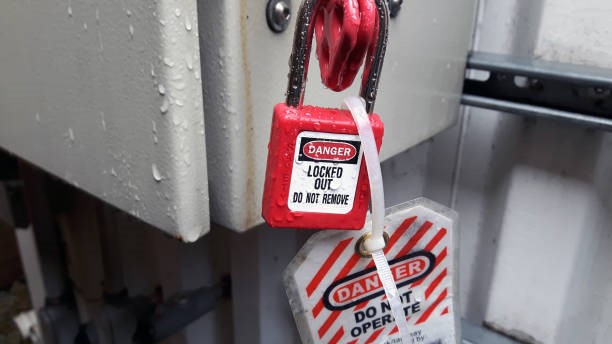
Level 2 Award in Electrical Lockout/Tagout Procedures
Level 2 Award in Electrical Lockout/Tagout (LOTO) Procedures
Course Overview
The Level 2 Award in Electrical Lockout/Tagout Procedures provides participants with comprehensive knowledge and practical skills to safely isolate electrical energy sources. This training focuses on the implementation of Lockout/Tagout (LOTO) procedures to prevent electrical hazards during maintenance, servicing, and repair activities. It emphasizes compliance with legal requirements and industry best practices to enhance workplace safety and mitigate risks associated with unexpected energy releases.
This course is ideal for electricians, maintenance personnel, safety professionals, and supervisors responsible for electrical safety.
Benefits
- Enhanced Workplace Safety: Minimize the risks of electrical shocks, arc flashes, and equipment-related injuries.
- Regulatory Compliance: Meet legal and industry-specific requirements for electrical safety.
- Operational Efficiency: Improve maintenance processes by ensuring clear isolation procedures.
- Incident Prevention: Reduce the likelihood of accidents caused by energy release.
- Professional Growth: Gain a specialized qualification to advance in the safety and electrical fields.
Learning Outcomes
Upon completing this course, participants will be able to:
- Understand the principles and importance of electrical Lockout/Tagout procedures.
- Identify electrical hazards and assess associated risks.
- Implement effective LOTO procedures to isolate electrical energy sources.
- Select and use appropriate LOTO devices and tools.
- Develop and enforce LOTO policies and procedures in the workplace.
- Monitor compliance and provide training for personnel involved in LOTO operations.
Study Units
Unit 1: Introduction to Lockout/Tagout (LOTO)
- Definition and purpose of LOTO.
- Legal and regulatory framework for electrical safety.
- Industry standards (e.g., OSHA, IEC).
Unit 2: Electrical Hazards and Risk Assessment
- Types of electrical hazards (e.g., shocks, burns, arc flashes).
- Conducting risk assessments for electrical tasks.
- Understanding the hierarchy of controls in electrical safety.
Unit 3: LOTO Equipment and Devices
- Types of LOTO devices (e.g., padlocks, tags, circuit breakers).
- Selection criteria for LOTO tools.
- Inspection and maintenance of LOTO equipment.
Unit 4: Developing and Implementing LOTO Procedures
- Key steps in the LOTO process.
- Writing clear and concise LOTO procedures.
- Roles and responsibilities in LOTO implementation.
Unit 5: Practical Application of LOTO
- Isolating electrical energy sources.
- Securing equipment using LOTO devices.
- Verifying energy isolation and testing for zero energy state.
Unit 6: Monitoring and Continuous Improvement
- Conducting audits and inspections of LOTO practices.
- Identifying gaps and ensuring compliance.
- Updating LOTO procedures based on workplace changes.
Career Progression
This qualification opens up career opportunities in electrical safety and industrial operations, such as:
- Electrical Safety Specialist: Develop and manage electrical safety programs, including LOTO procedures.
- Maintenance Supervisor: Oversee maintenance activities with strict adherence to LOTO policies.
- HSE Professional: Integrate LOTO procedures into broader workplace safety frameworks.
- Operations Manager: Ensure compliance with electrical safety standards in operational environments.
- Electrical Safety Consultant: Provide expertise on designing and implementing LOTO systems.
By completing this course, participants position themselves as valuable assets in industries requiring stringent electrical safety protocols.
Our assessment process is designed to ensure every learner achieves the required level of knowledge, skills, and understanding outlined in each course unit.
Purpose of Assessment
Assessment helps measure how well a learner has met the learning outcomes. It ensures consistency, quality, and fairness across all learners.
What Learners Need to Do
Learners must provide clear evidence that shows they have met all the learning outcomes and assessment criteria for each unit. This evidence can take different forms depending on the course and type of learning.
Types of Acceptable Evidence
Assignments, reports, or projects
Worksheets or written tasks
Portfolios of practical work
Answers to oral or written questions
Test or exam papers
Understanding the Structure
Learning outcomes explain what learners should know, understand, or be able to do.
Assessment criteria set the standard learners must meet to achieve each learning outcome.
Assessment Guidelines
All assessment must be authentic, current, and relevant to the unit.
Evidence must match each assessment criterion clearly.
Plagiarism or copied work is not accepted.
All learners must complete assessments within the given timelines.
Where applicable, assessments may be reviewed or verified by internal or external quality assurers.
Full learning outcomes and assessment criteria for each qualification are available from page 8 of the course handbook.
Top Courses
No results found.
Related Courses
Let's Get in touch
Deleting Course Review
Course Access
This course is password protected. To access it please enter your password below:



